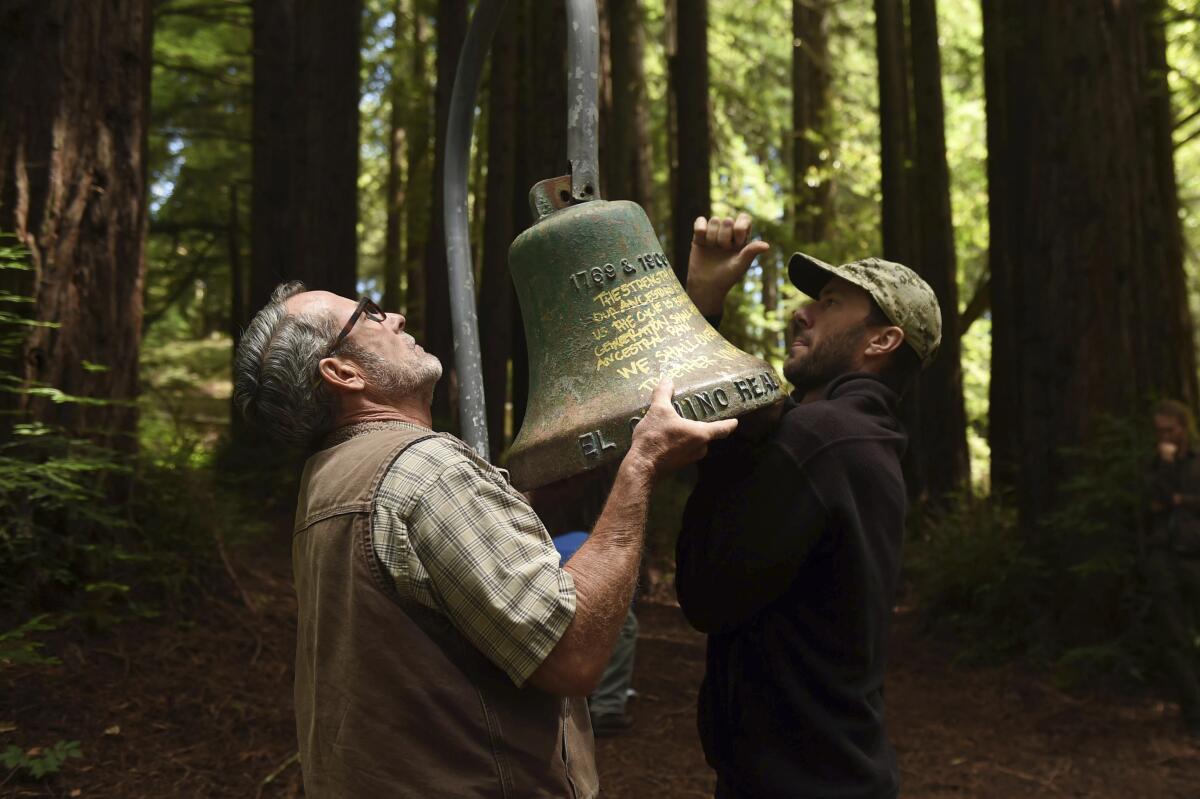Op-Ed: Why the California ‘mission bell’ road markers must come down

- Share via
Few symbols in California are as ubiquitous as the roadside markers shaped like mission bells that flank state highways and the streets of coastal cities from San Diego to Sonoma along the so-called El Camino Real. They celebrate the Spanish mission system, which seized Indigenous lands and sought the elimination of tribal cultures, spiritual practices and ways of life.
The bells must come down — and there are about 585 of them.
My tribe, the Amah Mutsun Tribal Band, is descended from Indigenous people who were taken to Missions San Juan Bautista and Santa Cruz along California’s Central Coast. We stand with many other Indigenous people in the state in calling for the complete removal of the bell markers.
Mission bells are a potent symbol of the domination and enslavement of our ancestors, who toiled long hours without pay in the mission compounds and were subjected to many forms of abuse. The clanging of the bells regimented the day’s compulsory schedule, and failure to respond to the call of the bell could result in severe punishment.
The decorative roadside bells we see today were invented in the early 1900s as a means of promoting tourism and settlement in California. Civic boosters, automobile associations, real estate developers and women’s clubs appropriated the mission bell to mark the route of a new state highway that linked the 21 missions of California. They named the 600-mile trail El Camino Real or the “Royal Road.”
The looming presence of these markers on state roadways exacts a psychological toll on Indigenous people. The bells serve as constant reminders of the suffering of our ancestors in the mission system, and of how many Californians remain woefully uniformed about this tragic history.
The installation of the bell markers coincided with repurposing the crumbling historic Spanish missions into tourist destinations. Fanciful, whitewashed historical narratives of the missions as places of convivial, peaceful collaboration between padres and willing Native American converts began to be widely promoted and eventually entered the grade-school curriculum.
These insulting historical narratives are not only false, they serve to erase the voices and actual experiences of the Indigenous people who were held captive in the missions, and who perished in astounding numbers. According to the California Native American Heritage Commission, about 100,000 Indigenous people died as a direct consequence of the missions, nearly a third of the estimated Native American population of California at that time.
The bells put a tourism-friendly spin on the history of the missions, one that tries to rewrite California history, obscuring the fact that many tribal communities survived the mission system and continue our cultural practices to this day. The bells also help conceal the reality of widespread resistance to the missions by Indigenous people, who often attempted to escape and staged revolts.
The missions left most of our tribal communities landless within our own territories. Everything was taken from us. Families that descend from mission survivors continue to experience the effects of historical trauma, which is related to the high rates of depression, addiction, suicide, poverty and incarceration in our communities.
It is truly shameful that these places where our ancestors were enslaved, raped, tortured and exposed to fatal diseases have been converted into tourist attractions and, in many cases, wedding venues. Instead, the missions should be places for the public to learn about what really happened to Indigenous people in the mission era and bear witness to the atrocities that took place.
The bells have started to come down. At the request of Amah Mutsun tribal members, UC Santa Cruz removed its El Camino Real bell in 2019. A year later, the city of Santa Cruz became the first California city to resolve to remove its mission bell markers; two sites remained. And the City of Hayward, following talks in 2020 with local tribal representatives, reversed plans to install an El Camino Real bell in a public plaza.
Not all of our tribe’s efforts to reach out to decision-makers have been well received. The city of Gilroy installed a new El Camino Real bell downtown in January, despite fervent requests to reconsider. This disrespectful action demonstrates that much work remains to be done, and that many are reluctant to let go of the sugarcoated state history they learned to identify with in their youth.
We recently launched a petition urging Gov. Gavin Newsom and the California Legislature to remove the bell markers from Highway 101 and other state property. Where appropriate, state agencies — working with local tribal leaders — could replace them with new historical markers or educational signs honoring Indigenous peoples of the area.
Steps must be taken to begin addressing the damage caused by more than a hundred years of the promotion of harmful myths about the missions. The city, county and state agencies and organizations that erected the El Camino Real bells should fund and facilitate initiatives aimed at telling the truth about how our ancestors were treated in the mission era.
Defenders of the El Camino Real bells often say that removing them is “erasing our history,” echoing a common refrain of advocates for retaining Confederate statues. In fact, our movement to remove the bells is a call for California to acknowledge and confront its true history, no matter how difficult, so that all of us — whether Native American or non-Native — may begin to heal.
Another generation of young tribal members should not have to grow up living under the shadow of the mission bell. Send these bell markers to the scrap heap — and stop promoting the mission myths they herald.
Valentin Lopez is chair of the Amah Mutsun Tribal Band.
More to Read
A cure for the common opinion
Get thought-provoking perspectives with our weekly newsletter.
You may occasionally receive promotional content from the Los Angeles Times.










